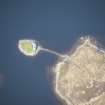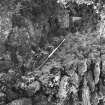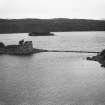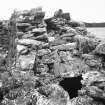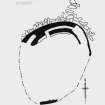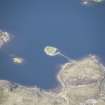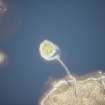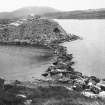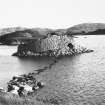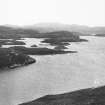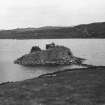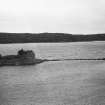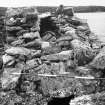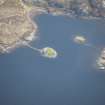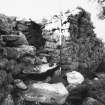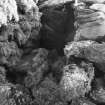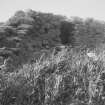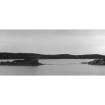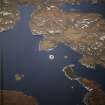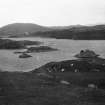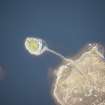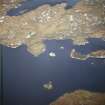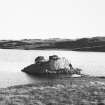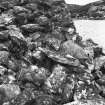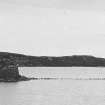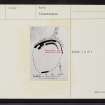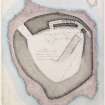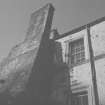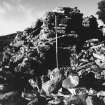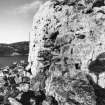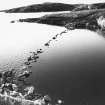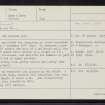Lewis, Great Bernera, Loch Baravat, Dun Baravat
Broch (Iron Age), Galleried Dun (Iron Age)
Site Name Lewis, Great Bernera, Loch Baravat, Dun Baravat
Classification Broch (Iron Age), Galleried Dun (Iron Age)
Canmore ID 4089
Site Number NB13NE 2
NGR NB 15598 35563
Datum OSGB36 - NGR
Permalink http://canmore.org.uk/site/4089
- Council Western Isles
- Parish Uig
- Former Region Western Isles Islands Area
- Former District Western Isles
- Former County Ross And Cromarty
GREAT BERNERA (Beàrnaraigh Mhòr)
The five villages of Bernera, the only island in Loch Roag now inhabited, are linked to the main island of Lewis by Blyth & Blyth's bridge of 1952, which made pioneering use of pre-stressed concrete girders.
Dun Baravat, 300-200 bc Iron Age roundhouse on islet in Loch Baravat, with evidence of intra-mural galleries and other elements of broch construction, although it was irregular-shaped and never a broch tower. Reconstructed horizontal Norse mill, 10 minutes walk over Airigh Ard from road's end. Bosta (Bòstadh)
Iron Age village, probably first occupied more than 1,500 years ago, overlooking the creamy sweep of Bosta Beach. It was concealed beneath the machair until 1993, when a severe storm exposed the site. Excavations in 1996 revealed a complex of semi-subterranean, drystone dwellings, now vestigial, overlaid by a Viking house. The local history society has built a life-size reconstruction of one of the Iron Age dwellings nearby.
Cliff, Valtos (Bhaltos), Kneep (Cnip), Reef Ring of traditional crofting and fishing settlements on a wing-shaped peninsula rich in archaeological remains. These include the causewayed islet Dun Baravat, a complex roundhouse on a hill loch; the excellently preserved lower part of a broch tower on Loch na Berie, overbuilt with later cellular structures until c.9th century AD; five 19th century grain mills, above the road at Traigh na Berie, and an Iron Age wheelhouse complex at kneep.
Taken from "Western Seaboard: An Illustrated Architectural Guide", by Mary Miers, 2008. Published by the Rutland Press http://www.rias.org.uk
NB13NE 2 15598 35563
(NB 1558 3555) Dun Baravat (NR)
OS 6" map, (1965)
Dun Baravat, a galleried dun occupying an islet connected to the shore by a causeway 100' long. It measures internally 40' by 30' within the ruin of a galleried wall, the north sector of which still stands to a height of 11', measures 8' in thickness, and exhibits the remains of part of a scarcement and an upper gallery.
A secondary building lies partly within and partly over the ruin of the wall.
R W Feachem 1963; RCAHMS 1928, visited 1914.
Dun Baravat is as described and planned by the RCAHMS. A basal gallery 0.8m wide, beneath that described, has been exposed for a length of about 3.1m.
Visited by OS (N K B) 22 June 1969.
Alternatively classified as broch.
J N G Ritchie and M Harman 1985.
Field Visit (19 June 1914)
Dun Baravat, Loch Baravat, Great Bernera.
On a small islet, about 35 yards south of a small peninsula on the eastern side of Loch Baravat, Great Bernera, about 1 mile north-west of the pier at Barraglom, are the remains of the broch Dun Baravat, the wall of which rises from the water's edge. On plan the dun is sub-oval, with diameters of 56 ½ feet from north-north-east to south-south-west and 43 feet transversely. The northern segment of the wall is fairly complete to maximum height of 11 ¼ feet with a thickness varying from 6 to 8 feet, and contains, above the scarcement, an upper and lower gallery * with a cell at an intermediate level towards the north-west, beside which the entrance appears to have been situated. The greater part of the dun is reduced to a mass of debris, and the arrangement of the interior is further obscured by secondary building, probably a shieling, which has incorporated the part of the wall which still remains. The lower passage is 4 ½ feet high, and varies in width from 1 ½ to 2 ¾ feet; the upper passage is reduced to the footing; the cell is 3 ½ feet high and 20 inches wide. The dun is approached by a causeway on the north, 100 feet long. (Fig. 30.)
RCAHMS 1928, visited 19 June 1914.
OS map: Lewis xvii.
*Capt. Thomas shows a stair within the gallery. Arch. Scot., Vol. V., Part III., Plate xlviii.
Measured Survey (23 July 1923)
A plane-table survey of this site was taken by RCAHMS on 23 July 1923. The resultant plan was redrawn in ink and published at a reduced size in RCAHMS 1928 as Figure 59.
Publication Account (2007)
NB13 1 DUN BARAVAT 2 ('Dun Bharabhat 2', 'Dun Burravat')
NB/1558 3535
This unexcavated D-shaped or promontory semi-broch, or (in old-fashioned terminology) galleried dun, on the island of Great Bernera, Lewis, stands on a small rocky islet in Loch Baravat (or 'Bharabhat', pronounced 'Varavat', in Gaelic) and about 32m (35 yd) from a small peninsula, to which it is connected by a stone rubble causeway. The site has the same name as NB03 1 – which is on an island in another Loch Bharabhat – so the original Gaelic form is preferred for the former and the anglicised version for this one [4, 172] (visited June 1985 and in Aug. 2001).
The building is sub-circular, con-forming to the shape of the islet, and the wall is of uneven thickness. At one point in the outer face the bedrock rises up into a knob and the masonry has been skilfully built over it.
The site is of considerable interest because of the unusual nature of the hollow-wall construction which, so far, has no parallels elsewhere. The site, and most of Loch Baravat, is out of view from the road; although no notice board identifying Dun Baravat was present in 2001 a line of well separated green posts was found to lead the visitor from the cattle grid to the causeway's end. The causeway should be crossed with care.
1. Description
In spite of its odd shape this site has been described as a broch [3], and sometimes as a “galleried dun” [4, 6], and an explanation for its identification here as a semibroch is given below. Only the third of the wall facing the causeway now stands to any height and this rises from the water's edge. The rest of the circuit consists mainly of rubble partly hidden by vegetation. The causeway is 30m (100 ft) long and made of an enormous quantity of piled-up stone in fairly deep water; most of it is now below the surface. Like many other island brochs and duns the drystone wall is festooned with lichen, which could give an approximate indication of its age.
1.1 Captain Thomas’ survey
There is no modern plan, elevation or cross-section of Dun Baravat (the RCAHMS plan lacks an elevation) but Thomas' drawing serves very well, even though he did not interpret all the architectural features as we would now. It is also very useful as it shows a site somewhat better preserved than it is now. Despite this the later Discussion must be regarded as tentative in the absence of a modern survey. Thomas' text is reproduced here (the paragraphs are here lettered for ease of reference).
(A) "Dun Bharabhat (pronounced Varavat) is situated about the middle of a large lake in Great Berneray; on a small islet, 20 fathoms from the grass-line. It is approached by the usual row of stepping stones, but in this instance the door of the dun does not face the causeway. The dun (Plate XLVIII) fills the whole island. It is now little better than a heap of stones.; on the east side however, the wall is still 14 feet high. The plan of what remains can only be understood by supposing that but one-fourth of the enceinte is original; the remaining being of subsequent formation. The ground plan of the original dun was not circular, for what remains of it is not the segment of a circle; it probably, in some degree, followed, like the present ruin, the outline of the little island. The present dun is of an irregular four-sided figure, with curved sides, undulating, however, on the west. The longest diameter of the dun is 47 feet, the shortest 40 feet.
(B) The door of the dun is at the north corner, from thence the west side is hardly traceable; but I do not believe it is other than a solid wall, without cells or passages; this wall appeared to be from 8 to 5 feet in thickness.
(C) The south and east sides have likewise been solid walls; at the east corner the old work begins and continues to the doorway. This part is very interesting, the exterior masonry is as good as is usual in the "Pictish castles." From the area [that is, the central court. Thomas did not suspect that a large ground-level doorway existed under lintel e, but it is clearly visible now] there is no apparent entrance, at the ground level, to the galleries in the wall; but there is a broad coping or cornice, formed by flat stones projecting from 8 to 14 inches, and which, I do not doubt, supported a floor. Above this coping are two doorways; the eastmost lands upon the roof of the ground gallery, and, on the left hand, a flight of steps descends to the ground, but is then blocked, as shown at (d). This forms a cellar, as there is no exit into the area. On the east: side of the door, the floor continues for 4 feet, and is then ruined.
(D) The second doorway (e) is 4 feet. high and 2.5 feet wide; on entering the west side is blocked at once, the wall here being solid, and nearly 8 feet thick; turning to the right the slabs are flat for 5 feet; then a flight of steps (f) leads to the third gallery, which is perfect for 9 feet.
(E) Over the westmost door is a third ope or window (g) which led to or lighted the fourth gallery. The roof of the third ope formed the floor of a gallery, from which a descending flight of stairs (h) appeared to have led to a gallery over the main entrance, but this part has been removed. The system of opes and galleries in this dun is very curious and shows that these ancient towers are not mere copies of another, although the observer soon perceives a great similarity in style and method.
(F) The area of the dun is filled with displaced stones, and overgrown with brambles and honeysuckle, but we traced part of a wall of a rectangular hovel which had, no doubt, been a refuge for some turbulent spirits in medieval times.
(G) I have learnt no traditions connected with this dun." (Thomas 1890, 391-92).
1.2 The Building
Level 1: the entrance is no longer visible because of fallen rubble but was observed by Thomas to be facing north-west, well to the left of the axis of the causeway which is aligned just east of north); his plan shows the end of the causeway too far to the west and too close to the entrance. He could not see any door-frame in the passage, presumably because it was buried. The Commission's plan implies that the passage was completely obscured in 1914. The building is so badly ruined now, and so strewn with rubble, that it is impossible without extensive clearance to work out the design of the hollow-wall construction of the ground level in the northern arc of the wall without the clues provided by previous observers.
There is definitely a ground level gallery at the east end of the high wall; an opening here shows a small part of it immediately behind a stairway (the upper surface of which is buried under rubble). The author has a piece of video film showing these steps; it also shows that the flat lintels up to which the steps lead are at scarcement scarcement level. This is the Level 1 stair marked on Thomas' elevation which leads up to void c in Level 1 (now vanished). Thomas observed that this void led on to the lintels of the ground gallery but only two now remain in position at the top of the flight, less than half of those visible in the mid 19th century. Evidently the stair was short and led to a landing. Thomas thought that this stair led down into a cellar (d) but this is highly unlikely to be the case because of the existence of a large doorway j in Level 1 a short distance to the west which he did not recognise, The large innermost lintel of this doorway forms part of the scarcement and is clearly visible at the base of void e. Thomas seems not to have recognised this lintel for what it is and assumed that there was no opening from the “area” into the ground level intra-mural spaces; he evidently though that the scarcement supported the primary flooring of the dun.
Thus the short stairway in Level 1 seems likely to have led up to a landing at scarcement level from which void c led out on to the scarcement – presumably supporting a raised wooden floor – in typical broch fashion. The buried door-way – labelled j here – below void e will then be the stair doorway and there ought to be a length of gallery leading to its right to the foot of the stair (the end of the “cellar” should thus be fallen rubble). Likewise this gallery probably runs to the left of the stair doorway, almost to the entrance passage, but the exact nature of these intra-mural spaces in Level 1 will not be known until the building is cleared out and consolidated.
There seems to be general agreement that the rest of the wall enclosing the islet is solid (without a gallery) and thinner and lower than the high wall in the north-west/north-east arc. Thomas supposed it to be later than the hollow wall, presumably because he assumed that Dun Baravat was originally a sub-circular broch with a high wall all the way round.
Level 2: the high part of the wall still contains the remains of two superimposed galleries and has a ledge scarcement on the inner face, just above the present top of the rubble filling the central court. Presumably this ledge is about 1.8m (6 ft) above the original floor, and it defines, as usual, the base of Level 1. Thomas' elevation shows a double void in the inner face above the scarcement – g above e. This is still reasonably well preserved, although both lintels have fallen; the lower opening was 1.2m (4 ft) high in 1861. The massive lintel at the bottom of void e is now clearly exposed and as noted Thomas did not suspect that there was a ground level doorway under it.
Another reason for his not suspecting it must be that he found another mural stair 1.5m (5 ft) to the right of void e which rose up to a second landing formed by the lintels of the Level 2 gallery. There was no reason at that time to doubt that this was the main broch stair, starting from Level 2 – a feature occasionally seen in some brochs (like Midhowe and Gurness in Orkney (HY33 1 and HY32 2). However in such cases the wall below the stair door is solid, unlike Dun Baravat). Yet such a double stair – the two parts partly overlapping each other – is otherwise unknown in brochs and broch-like structures and is commented on further in the Discussion.
Thomas entered void e and found the gallery immediately to his left blocked with what appeared to be the solid wall of the dun nearly 2.4m (8 ft) thick. How-ever it seems highly improbable that a stretch of solid wall could exist in Level 2 especially as the west end of the raised gallery or cell leading northwards towards void e from the entrance, observed by the Commission, is still visible. Thomas may have seen a mass of rubble to the left of e and assumed it to be a wall. A short distance to the right of opening e he found the second stair, already mentioned, which rose in a short flight up to the lintelled floor of the gallery in Level 3, which formed another landing. It may be that this stair gave access – by way of the opening which presumably existed above c, to a second wooden raised floor.
The opening of the longitudinal gallery or cell running north-east from the entrance can still be seen at the west end of the high wall. Thomas' description and his elevation drawing of this gallery (shown with dotted lines) shows it meeting the entrance on the first floor (Level 2), in which case it should have connected with the chamber over the entrance, now vanished. The Commission describes this opening as being “at an intermediate level” [3] but the difference is probably to be explained by the fact that at present there are no clues from the entrance itself concerning the height of its roof, though we can assume it to have been at scarcement level.
Thomas' drawing also implies that in 1861 the north-east side of the entrance was standing 3.05m (10 ft) high – more than 1.5m (5 ft) above the scarcement; in this case the north-east side of the chamber over the entrance would have been well preserved, as seems to be the case on his elevation. Unfortunately the author did not measure the levels of the apparently raised gallery at the west end and of the scarcement.
Levels 3 and 4: Thomas' elevation shows three complete galleries in the high wall, starting at ground level, so there was obviously one in Level 3 together with void g [2, pl. XLVIII]; nothing of Level 3 survives now. As mentioned Thomas saw a flight of steps 1.5m (5 ft) to the right of e leading up on to the lintels dividing the galleries of Levels 2 and 3 which were preserved for 2.7m (9 ft). Void g was of course in Level 3 and the 1861 elevation shows a few lintels still remaining at the height of its top; these of course formed the dividing line between the galleries of Levels 3 and 4. To the left of void g – that is, towards the entrance passage – Thomas saw what he took to be yet another flight of stairs rising from near the entrance passage up on to the lintels at the base of Level 4 (h on the elevation). If his elevation records the masonry at the west end of the wall accurately these steps appear to rise from the (Level 3) chamber above the chamber over the entrance, assuming that such existed. However he says that “this part” (of the entrance) “has been removed” so only a few steps of the high stair evidently remained.
2. Discussion
2.1 Making sense of the site
Dun Baravat is a highly unusual site which, while its hollow-walled architecture is very close to that of the brochs, nevertheless has some unique features. Its very ruined condition, the fact that it is unexcavated and full of rubble and the peculiar nature of some of the intra-mural features, could all tempt one to assume that Captain Thomas misinterpreted some of these features – for example the pair of overlapping stairs and the high stair (now vanished) leading down from Level 4 towards the entrance passage. It is fairly clear moreover that he did make a basic error in assuming that there was no ground level doorway from the enclosed area into the intra-mural spaces. What is more the further destruction that has occurred since 1861 makes it impossible to verify some of his observations about the higher parts of the wall.
For all these reasons one could simply assume that Dun Baravat is in fact the much-altered remains of a ruined island broch like Dun Cromore (NB42 1), albeit one with a markedly irregular plan. One could then agree with Thomas that the thin and apparently solid wall that encloses most of the islet is a later construction which, for some reason, had replaced the high hollow wall of the broch for more than two thirds of its circuit. The peculiar multiple staircases are of a kind found in no other broch or broch-like building and could be explained as misinterpretations of features which in 1861 were largely obscured by rubble; it could then be assumed that the hollow-wall architecture would be found to be quite normal when excavated.
The author went along this path of reasoning for a while but then had doubts, mainly because it is surely neither rational nor fair to Captain Thomas to assume that this careful observer thought he saw things which were in fact not there simply because we cannot see them now and have not seen them anywhere else. This is a completely different mental procedure to the reasonable one of seeing more than the previous observer saw and thus – with the benefit of greater information – reinterpreting his views. An example is the stair doorway in Level 1, already discussed.
There are two aspects to the site to be considered here. First, was Dun Baravat a sub-circular island broch or a promontory semibroch in an unique situation? Second, are the peculiar multiple stairs which were seen in the high wall in 1861 likely to be genuine and, if so, what was their purpose? These questions are of course linked but, as noted earlier, the conclusions drawn here must be tentative until the site is properly explored. The only major assumption made in the following discussion is that Thomas' “cellar” in Level 1 is imaginary and that it was in fact part of a ground gallery blocked by rubble; it is supposed that he was misled over this by not seeing the large lintelled doorway under void e.
2.2 Broch or semibroch?
Simply from the point of view of plausibility the semibroch diagnosis seems more plausible. To assume that Dun Baravat was once a broch like Dun Cromore it has also to be assumed that two thirds or more of the massive high hollow wall – the entire enclosure away from the causeway – was for some reason completely demolished down to foundation level and then replaced with a lower, thinner version. Even apart from the fact that no other known broch has received this treatment it does not make sense. An island broch tower like Dun Cromore (NB42 1) looks like a very secure stronghold, even though easily approached by boat. To undertake the huge effort of removing most of its high wall and replacing it with a low one seems, to put it mildly, like wasted effort. There is also the point that the ground plan of Dun Baravat is much more irregular than that of any other known broch. Even the sub-circular examples seem to follow carefully laid-out shapes.
If Dun Baravat was built as a promontory semibroch rather than as an oval or sub-circular broch tower then it must surely belong to a period well before the development of the towers. Comparing this site with Dun Cromore it is hard to believe that a simple high barrier at the end of a causeway would be chosen if the ability to build a tall round tower had been available. The risks of the stronghold being attacked by boats at night would surely have been thought too great unless the concept of the tower broch was then unknown. Even the argument for contemporaneity – for example that a full scale tower was too expensive for these builders – seems weak in the context of safety.
2.3 The multiple stairs
In this context the peculiar features of the high section of the wall – facing the causeway – may make better sense. If the slightly curved, high hollow wall at Dun Baravat was quite short – not more than about 15.25 – 18.30 m (50 - 60 ft) at the most – it would have been impossible to design an intra-mural stair to the wallhead (in Level 5 or 6) in the broch tower style – that is as a continuous flight incorporating one or two landings. Since the structure remains unexcavated and badly ruined it is not possible to be sure about the details but two or three short flights in the high wall might have served the same purpose. The large doorway j gives access to the stair which would have been in everyday use – that leading to the low doorway c in Level 2 and thence out on to the wooden floor which presumably rested on the scarcement. However this stair, which ends in a long landing, can hardly have risen up to Level 3 as the east end of the high section of the wall must be quite close.
A way up to Level 3 seems to be provided by the stair in Level 1 which rises a short distance east of doorway e, again up to a landing of lintels which cannot be far from the end of the high wall. The gallery in Level 4 was evidently reached by a high stair further west which appears to rise up somehow from the entrance passage. Thomas' elevation does not show clearly how this happened (presumably because of the ruined state of the upper part of the wall) but – judging from the position and angle of the flight shown – it could either have come straight up through two Levels from the chamber over the entrance (which would have been directly accessible from the raised wooden floor in the interior) or from the gallery in Level 3 which ran over the top of that.
In the latter case another, curved flight might have existed to the west of the entrance passage, leading up from a doorway at ground level the remains of which presumably still exist under the rubble. This latter hypothesis seems preferable simply because the Level 2 gallery running east from the entrance is still partly open and visible and no stair has been noted inside it (the author did not look inside, not having thought in detail about the design of the stairways until 2004). It is also more plausible because – unlike the first option mentioned – it allows for access to the raised galleries in the short section of high wall which must surely have existed to the west of the entrance (although these could have been reached from the various tiers of the void over the entrance).
It is striking how the pattern of intra-mural stairs at Dun Baravat – which appears unique and baffling at first sight – makes reasonably good sense if the site is interpreted as a promontory semibroch.
The structure also makes more sense in a pre-broch tower context if it is remembered that the high stretch of the wall facing the causeway not only doubtless served as a high vantage point from which the occupants could defend the site, but also because the high wall supported a possibly quite complex system of raised wooden floors and shelters for the inhabitants to live in reasonable comfort. On such a tiny island such a vertical system of living spaces would have been of first importance.
3. Dimensions
External diameters: north-north-east to south-south-west by west 17.23m (56.5 ft) ; south-east by south to south by south-west 13.1m (43 ft). Dun Baravat was surveyed by Captain F W L.Thomas in 1861 (he called it 'Dun Bharabhat’, contrary to what is suggested here) and he found that the high part of the wall stood 4.3m (14 ft) high. Since that time it has become somewhat more dilapidated, its greatest height being 3.43m (11.25 ft) in 1914 [3]. It is now slightly lower. In the middle of the 19th century the Level 1 raised doorway or void above this assumed stair doorway (1.2m or 4.0 ft high) was complete and lintelled over, as was the void on top of it; the bases of the sides of a third void were preserved on top of that (Level 4). Thus the wall must then have been at least half as high again as it is now, including the buried Level 1.
Sources: 1. NMRS site no. NB 13 NE 2: 2. Thomas 1890, 391-2 and pl. xlviii: 3. RCAHMS 1928, 20-1, no. 71 and figs. 30 and 59: 4. Feachem 1963, 182: 5. MacKie 1992, 172-75, fig. 9 and pl. XI, A and B: 6. Burgess 1999.
E W MacKie 2007


















































